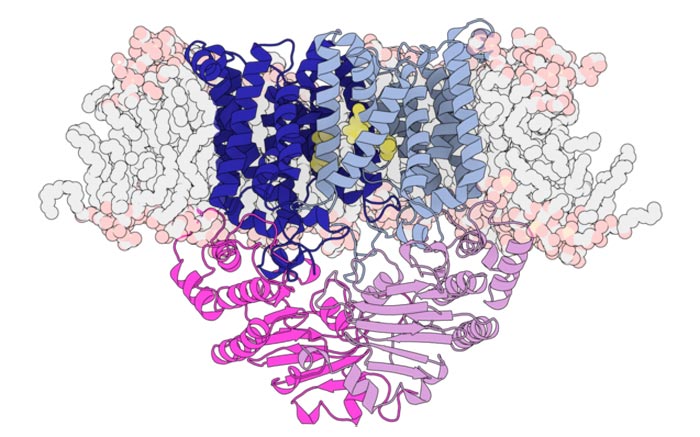Starving pneumonia-causing bacteria of its favourite “food” holds promise for new antibiotics

The structure with the transmembrane regions in blue, the energy driving domains in pink and the membrane lipids as pale grey with pale orange heads. The yellow 'blobs' represent the position of the gating residues in the pathway.
Credit: Hugo MacDermott-Opeskin, Megan O'Mara and Christopher McDevitt
Australian researchers have revealed how the bacterium Streptococcus pneumoniae (pneumococcus) obtains the essential nutrient, manganese, from our bodies, which could lead to better therapies to target what is a life-threatening, antibiotic-resistant pathogen.
Pneumococcus is one of the world’s deadliest organisms, responsible for more than one million deaths each year and is the leading infectious cause of mortality in children under five. It is the main cause of bacterial pneumonia, as well as a major cause of meningitis, sepsis and inner ear infections (otitis media).
Published today in Science Advances and after ten years of detailed investigations, researchers from the Peter Doherty Institute for Infection and Immunity (Doherty Institute) and the Bio21 Molecular Science & Biotechnology Institute (Bio21), along with collaborators at the Australian National University and Kyoto University, Japan, have determined the structure of the unique ‘gateway’ that pneumococcus uses to steal manganese from the body.
All organisms, including pathogens, need vitamins and minerals to survive. While researchers knew that manganese was critical for survival of the pneumococcus, how it took manganese from the body wasn’t understood.
University of Melbourne Associate Professor Megan Maher, a laboratory head at Bio21, said they noticed the bacterium was drawing in nutrients in a regulated way.
“Eventually we discovered that this was due to a unique gateway that sits in the bacterium’s membrane that opens and closes to specifically allow manganese in,” said Associate Professor Maher.
“This is a completely new structure that has never been seen in a pathogen like this.”
University of Melbourne Professor Christopher McDevitt, a laboratory head at the Doherty Institute, said the study’s finding changes what we know about the pathogen’s survival.
“Previously, it was thought that these gateways acted like Teflon coated channels in the sense that everything just flowed through,” explained Professor McDevitt.
“Now we understand that it is selectively drawing the manganese in. Any disturbance of this gateway starves the pathogen of manganese, which prevents it from being able to cause disease.”
It could hold the key to better and alternative therapies against the pneumococcus.
Although a pneumococcal vaccine does exist, it only provides limited protection against circulating strains, and antibiotic resistance rates are rapidly rising.
“It’s a really attractive therapeutic target as it sits on the surface of the bacterium, and our bodies don’t use this type of gateway,” Professor McDevitt said
“At a time when we are seeing rising resistance to our first and last line antibiotics, and the emergence of ‘superbugs’, it is important that we think of new strategies to control this deadly organism.”
Journal: Science Advances
DOI: 10.1126/sciadv.abg3980
Article Title: The structural basis of bacterial manganese import
Article Publication Date: 6-Aug-2021
Media Contact
Doherty Media
catherine.somerville@unimelb.edu.au
Office: 61-383-448-378
All latest news from the category: Life Sciences and Chemistry
Articles and reports from the Life Sciences and chemistry area deal with applied and basic research into modern biology, chemistry and human medicine.
Valuable information can be found on a range of life sciences fields including bacteriology, biochemistry, bionics, bioinformatics, biophysics, biotechnology, genetics, geobotany, human biology, marine biology, microbiology, molecular biology, cellular biology, zoology, bioinorganic chemistry, microchemistry and environmental chemistry.
Newest articles

First-of-its-kind study uses remote sensing to monitor plastic debris in rivers and lakes
Remote sensing creates a cost-effective solution to monitoring plastic pollution. A first-of-its-kind study from researchers at the University of Minnesota Twin Cities shows how remote sensing can help monitor and…

Laser-based artificial neuron mimics nerve cell functions at lightning speed
With a processing speed a billion times faster than nature, chip-based laser neuron could help advance AI tasks such as pattern recognition and sequence prediction. Researchers have developed a laser-based…

Optimising the processing of plastic waste
Just one look in the yellow bin reveals a colourful jumble of different types of plastic. However, the purer and more uniform plastic waste is, the easier it is to…



